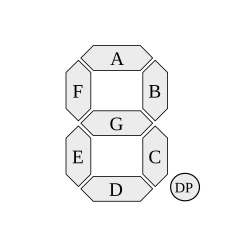2N2905 is an entirely adequate PNP switching transistor. Its H
FE is a little shitty compared to modern devices (min. 75 @Ic=10mA) and of course its in a big clumsy TO-39 can, but I wouldn't say no to a bag of them myself! Its even got a high enough voltage rating to be satisfactory if you need to use it on your HT rail for your VFD. Remember: Emitter by tab
2N1132 is rather less satisfactory: H
FE min. 25 @Ic=5mA, and I'd have to be truly desperate to use it.
I'll take a look at the Sparkfun link and get back to you.
NOTE '595 to LED segment ordering. D.P on the MSB then segments in alphabetical order with decreasing bit significance, because it makes the code slightly easier later, (specifically if you need to enter font tables in binary).

NOTE 2: Don't try to run more than 1 or 2 digits of the Arduino's onboard 5V regulator. It isn't man enough for the job. Use a 1A
max 5V supply (+/-5%) or a separate voltage regulator from the unreg supply to the Arduino. Don't just stuff a 7805 in the breadboard - if its ground leg comes loose it will kill your logic chips and probably your Arduino. Critical stuff like that is best soldered!
Caution: Also
DON'T use a 5V high current supply (e.g. old PC PSU) unless you protect the feed to your breadboard with a 1A or less polyfuse. (you can salvage them off really old 10base2 Ethernet cards - look for a yellowish disk that resembles a cap). Using a supply without a low enough current limit frequently results in a melted breadboard and blown chips at the slightest wiring mistake. Before using a USB charger or similar, check its output's a clean 5V (if you don't have a scope, stick a 1uF cap in series with your DMM to block the DC and put it on AC). You are looking for less than 0.05V ripple (0.15V pk-pk on a scope), both unloaded and into a 100mA load, a DC voltage that is within 5% of nominal at no load and doesn't drop too much loaded, and a safe shutdown if you short the output.
If shorting it makes it go bang or it outputs more than 2A shorted, its best to find out before you use it for anything valuable. Expect dirt cheap Chinese USB chargers to go bang! Also their safety clearances are often totally inadequate and you risk electrocuting yourself, your Arduino and your PC. . .



Get breadboarding!